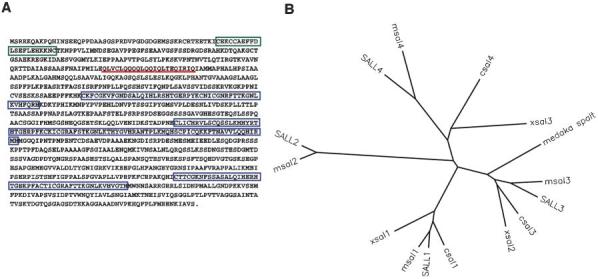Fig. 1.

Sequence analysis of csal4. (A) Amino-acid sequence of csal4. The nucleotide sequence has been assigned the GenBank accession number AY342354. The amino terminal CCHC zinc-finger region is boxed in green, the three C2H2 zinc-finger regions are boxed in blue and the glutamine-rich domain is underlined in red. (B) Dendogram of ClustalW analysis of vertebrate spalt genes. There are four paralog groups of spalt. csal4 is most closely related to Xsal3 and human SALL4. The proteins (and their accession numbers) used in this analysis: human SALL1 (Q9N5C2); human SALL2 (Q9Y467); human SALL3 (Q9BXA9); human SALL4 (Q9UJQ4); mouse msal1 (Q9ER74); mouse msal2 (NP_056587); mouse msal3 (XP_129051); mouse msal4 (BAC33598); chicken csal1 (AAG13011); chicken csal3 (AAK38370); Xenopus Xsal1 (AAG45108); Xenopus Xsal2 (T30341); Xenopus Xsal3 (JC7116); and medaka spalt (AAB51127). For clarity, the mouse genes are labeled to be consistent with the naming of the human genes.
